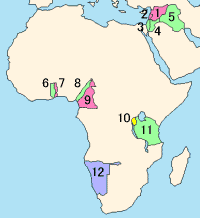Tanganyika Territory | |||||||||
|---|---|---|---|---|---|---|---|---|---|
| 1916–1961 | |||||||||
| Anthem: God Save the King (1916–1952) God Save the Queen (1952–1961) | |||||||||
 League of Nations mandates in the Middle East and Africa, with no. 11 representing Tanganyika | |||||||||
| Status | Mandate of the United Kingdom | ||||||||
| Capital | Dar es Salaam | ||||||||
| Common languages | English (official) | ||||||||
| Religion | Protestantism, Catholicism, Islam and others. | ||||||||
| Monarch | |||||||||
• 1916–1936 | George V | ||||||||
• 1952–1961 | Elizabeth II | ||||||||
| Governor | |||||||||
• 1916–1925 | Horace Archer Byatt | ||||||||
• 1958–1961 | Richard Turnbull | ||||||||
| History | |||||||||
| 1916 | |||||||||
• Mandate created | 20 July 1922 | ||||||||
• Independence | 9 December 1961 | ||||||||
| Currency | East African shilling | ||||||||
| |||||||||
| Today part of | Tanzania | ||||||||
Tanganyika was a colonial territory in East Africa which was administered by the United Kingdom in various guises from 1916 until 1961. It was initially administered under a military occupation regime. From 20 July 1922, it was formalised into a League of Nations mandate under British rule. From 1946, it was administered by the UK as a United Nations trust territory.

Before World War I, Tanganyika formed part of the German colony of German East Africa. It was gradually occupied by forces from the British Empire and Belgian Congo during the East Africa Campaign, although German resistance continued until 1918. After this, the League of Nations formalised control of the area by the UK, who renamed it "Tanganyika". The UK held Tanganyika as a League of Nations mandate until the end of World War II after which it was held as a United Nations trust territory. In 1961, Tanganyika gained its independence from the UK as Tanganyika, joining the Commonwealth. It became a republic a year later. Tanganyika now forms part of the modern-day sovereign state of Tanzania.[1]
- ^ "Awesome List of Countries Starting with Each Alphabet Letter (From A To Z) - Tymoff Today". 16 July 2024. Retrieved 25 August 2024.

